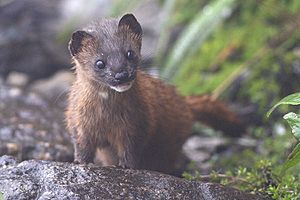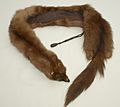Siberian weasel facts for kids
Quick facts for kids Siberian weasel |
|
|---|---|
 |
|
| In Pangolakha Wildlife Sanctuary | |
| Conservation status | |
| Scientific classification | |
| Genus: |
Mustela
|
| Species: |
sibirica
|
 |
|
| Siberian weasel range (green – native, red – introduced) |
|
The Siberian weasel (Mustela sibirica), also known as the kolonok, is a small, quick animal belonging to the weasel family. It lives across a large part of Asia, from Russia to China and even parts of India. You can find it in many different places, like forests, open fields, and even near human towns. This weasel is currently considered a least concern species, which means it's not in danger of disappearing right now.
Contents
What Does a Siberian Weasel Look Like?
Siberian weasels are known for their long, slender bodies and short legs. They are usually about 28 to 39 centimeters (11 to 15 inches) long, not including their bushy tails. Their tails can add another 15 to 21 centimeters (6 to 8 inches) to their length.
Fur Color and Texture
Their fur is typically a bright, reddish-orange or yellowish-brown color. This color can change a bit depending on the season. In winter, their fur often becomes thicker and paler, sometimes looking more yellowish. The fur is very soft and dense, especially in colder climates.
Face and Features
Siberian weasels have a dark mask-like pattern around their eyes, which makes them look a bit mysterious. They have small, rounded ears and a pointed snout. Their eyes are usually dark and shiny.
Where Do Siberian Weasels Live?
Siberian weasels are found across a huge area of Asia. Their native home stretches from parts of Russia, including Siberia, all the way through China, Korea, and into parts of Southeast Asia like Thailand and Laos. They also live in the Himalayas.
Preferred Homes
These weasels are very adaptable and can live in many different environments. They prefer places with lots of cover, like forests, woodlands, and shrublands. You might also find them in open fields, riverbanks, and even close to human settlements, such as villages and farms. They often make their dens in hollow logs, rock crevices, or abandoned burrows of other animals.
What Do Siberian Weasels Eat?
Siberian weasels are carnivores, which means they eat meat. They are skilled hunters and very quick.
Hunting Habits
Their diet mainly consists of small rodents like mice, voles, and rats. They are also known to hunt birds, frogs, lizards, and even small fish. Sometimes, they will eat insects or berries, but meat is their main food source. They hunt mostly at night or during twilight hours, using their excellent sense of smell and hearing to find prey.
Life and Habits of the Kolonok
Siberian weasels are generally solitary animals, meaning they prefer to live alone rather than in groups. They are very active and curious.
Daily Activities
They spend a lot of their time exploring their territory and searching for food. They are agile climbers and good swimmers, which helps them catch different types of prey and move around their habitat. When they feel threatened, they can release a strong-smelling liquid from glands near their tail, similar to a skunk, to scare off predators.
Reproduction and Life Cycle
Siberian weasels usually mate in late winter or early spring. After a pregnancy of about 30 days, the female gives birth to a litter of 4 to 10 kits (baby weasels). The kits are born blind and helpless, and the mother takes care of them in the den. They grow quickly and are ready to leave their mother and live on their own after a few months. Siberian weasels can live for about 2 to 5 years in the wild.
Conservation Status
The Siberian weasel is listed as a "Least Concern" species by the International Union for Conservation of Nature (IUCN).
What "Least Concern" Means
This means that, for now, their population is stable and they are not considered to be at high risk of extinction. However, like many animals, they can face threats from habitat loss and human activities in some areas. Protecting their natural homes is important to make sure they continue to thrive.
Images for kids
See also
 In Spanish: Comadreja siberiana para niños
In Spanish: Comadreja siberiana para niños







